As I reviewed the body of work submitted for this year’s Ocean Views Photo Contest, I was blown away. The images were stunning and diverse. There were pictures of single-celled organisms, surprising behaviors, the largest fish and mammals on the planet, rare animals and aerial pictures bordering on the abstract. Photographers explored the waters of every part of Earth — from the tropical Pacific’s pristine reefs to the icy waters of the Arctic and Antarctic.
The collection of photographs submitted embodies the perfect ocean portfolio; it is unsurpassed by the work of any single photographer and made possible only by the efforts of thousands of inspired ocean folk putting in millions of hours of work. Improvements in computer and camera technology have been incredible enablers, allowing photographers to capture subjects and behaviors that would have been nearly impossible only a decade ago. We are squarely in the middle of a wildlife-photography renaissance driven by the combination of extraordinary technology in affordable cameras and the ingenuity of today’s professional and hobbyist photographers.
Great photographers are great regardless of the camera they use. They have skills that enable them to succeed as image-makers: deep specialization, tremendous domain knowledge born from years of experience, near-infinite patience and the drive to obsessively pursue that perfect picture.
While experience is king, technology also plays an important role in today’s photography. New technology enables new techniques that allow photographers to create new kinds of images. When I started my career as an underwater photographer, digital cameras were not something professionals took seriously. Now they are the standard. During a single scuba dive, a photographer can fire off the same number of pictures that a productive photographer in the film days might have taken in a month. Instant review permits a feedback loop that dramatically enhances the learning process.
Cameras now feature advances such as image stabilization at the sensor level and incredible low-light performance. Underwater-housing manufacturers are fine-tuning ergonomics, and continuous lighting has moved almost exclusively to LED. Now lighting is on the same exponential performance-increase curve that home computers are on. Frame rates in still photography are pushing into video territory, and photographers are experimenting with filters, time-lapse and unusual perspectives (e.g., relay lenses for wide-angle macro). Computational photography is peeking at us from around the corner, giving us powerful lens- and aberration-correction abilities, real-time high dynamic range (HDR), smart multi-image capture and even really crazy things like light-field imaging, which allows perspective changes and refocusing of pictures after they’re taken.
Photographers are getting really good at documenting the ocean and its inhabitants at a particularly crucial time. It’s hard to overstate the threats of ocean acidification, climate change and overfishing. When I talk to experienced photographers decades older than me, they describe with great nostalgia the oceans of their youth. Unfortunately, no one will ever get to experience those oceans again, and even the best photography from that era is unable to successfully communicate it.
One of the driving forces of my own photography is the desire to document what I see in the ocean now so my descendants might have an idea of what it was like. Contests like Ocean Views aggregate the beauty of the ocean at a particular moment, creating a time capsule of excellence that will enable future generations to see what drove us to spend as much time as possible in and around the water.
— Eric Cheng, publisher and founder, Wetpixel.com; director of photography, Lytro Inc.
Grand Prize
Harp Seal Pup on Pack Ice
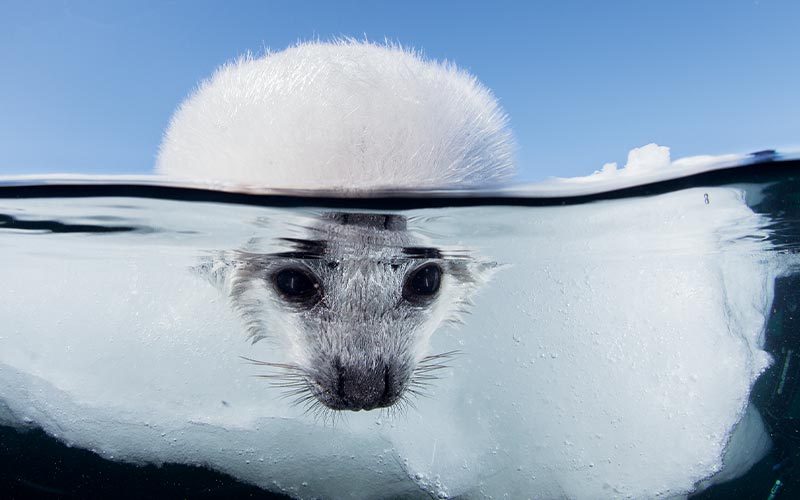
Îles de la Madeleine, Gulf of St. Lawrence, Quebec, CANADA
By Keith Monroe
“Sink or swim — that’s the reality for this and every harp seal pup. Five days on the ice led me to this image of a ‘white-coat’ pup peering into an unknown yet crucial part of its life, the open sea. It is instinctual for the pups to swim and dive, but there is apprehension about that first plunge. Newborn harp seals nurse for about three weeks after birth and can gain up to two pounds per day, although they lose much of it in the three weeks that follow, before they enter the water and begin feeding on marine life. I could relate to this pup’s hesitant curiosity as I pushed ice crystals away from my camera housing in the below-freezing water.”
Canon EOS 5D Mark ll, EF 15mm f/2.8 fisheye lens, 1/200 sec at f/16, ISO 400, Ikelite DS160 strobes (2), Aquatica housing, www.keithmonroephotography.com
First Place
Dugong and Golden Trevally

Marsa Alam, Egypt
By Douglas David Seifert
“I spent several days in the company of an extraordinary dugong known locally as Dyson. Dugongs are notoriously shy, unlike their cousins, West Indian manatees, but this particular dugong had a fairly high tolerance for human proximity. He is the only known dugong in the region and has a charismatic nature. The juvenile golden trevally accompany the dugong to forage upon small crustaceans unearthed while the dugong feeds upon seagrass.”
Canon EOS 5D Mark II, EF 16-35mm f/2.8L II USM lens, 1/200 sec at f/11, ISO 640, Inon Z-220 strobes (2), Seacam housing, www.douglasseifert.com
Second Place
Bobtail Squid
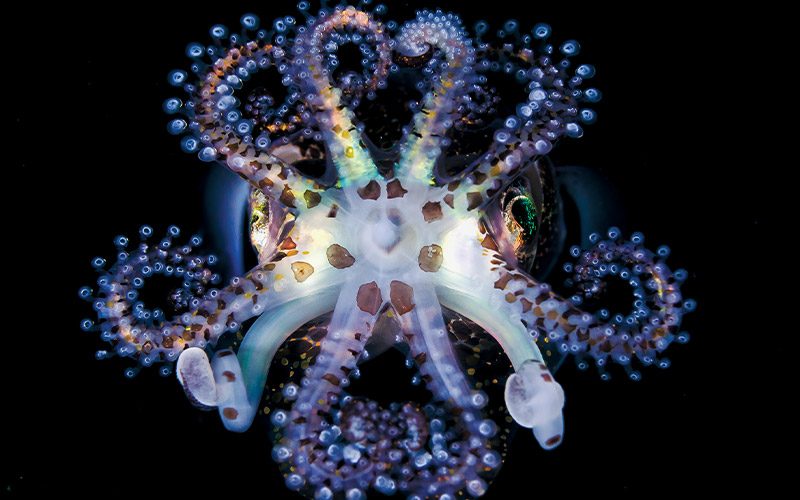
Anilao, Mabini, Batangas, Philippines
By Todd Bretl
“After half a dozen three-hour night dives photographing schools of reef squid, my dive guide and I chanced across this unusually large bobtail squid hovering in the water column. Normally these squid are found half buried in the sand, so it was a thrill to see one swimming. When I moved my camera port up close for a shot, the squid struck this pose, which lasted only a second. Interestingly, bobtail squids have special light organs that host glow-in-the-dark bioluminescent bacteria, which produce the brilliant iridescent colors seen here.”
Nikon D7000, AF-S Micro Nikkor 60mm f/2.8G ED lens, 1/320 sec at f/11, ISO 320, Sea & Sea YS-250PRO strobes (2), Nauticam housing, www.toddbretl.com
Third Place
Southern Minke Whale
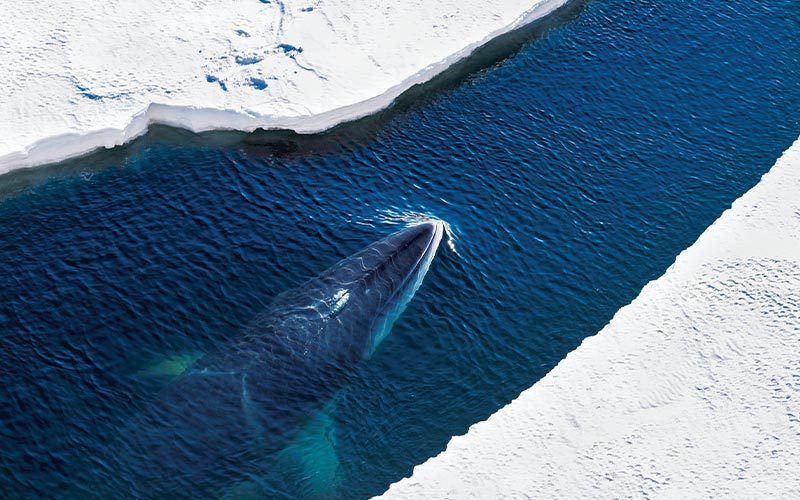
McMurdo Sound, Antarctica
By George Pellissier
“I was fortunate enough to have the opportunity to act as an ice pilot on the Russian icebreaker Vladimir Ignatyuk during the annual resupply of McMurdo Station, Antarctica. While holding position just off the station as one of the supply ships made its approach, this whale began using a small area of open water directly in front of the ship for air. Hearing its exhalations, I managed to get to the bow of the ship in time to take several shots of the whale surfacing.”
Nikon D7000, AF-S VR Zoom-Nikkor 70-300mm f/4.5-5.6G IF-ED lens at 70mm, 1/250 sec at f/8, ISO 200
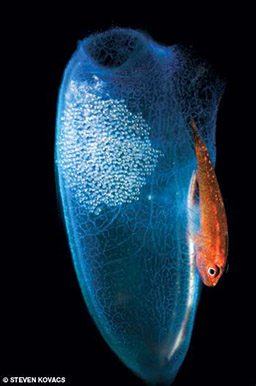
Fourth Place
Common Ghost Goby with Eggs
Tulamben, Bali, Indonesia
By Steven Kovacs
“During a recent trip to Tulamben, I had been looking for a goby guarding its eggs on a tunicate when I finally found one during a routine dive. Realizing that the tunicate lay against a distracting background, I attached a homemade snoot to one of my strobes and used a single, narrow beam of light from the side to isolate the subject and more clearly show this interesting parenting behavior.”
Nikon D7000, AF-S VR Micro-Nikkor 105mm f/2.8G IF-ED lens, 1/250 sec at f/40, ISO 100, Ikelite DS160 strobe with homemade snoot, Ikelite housing, www.underwaterbliss.com
Fifth Place
Twin Moray Eels
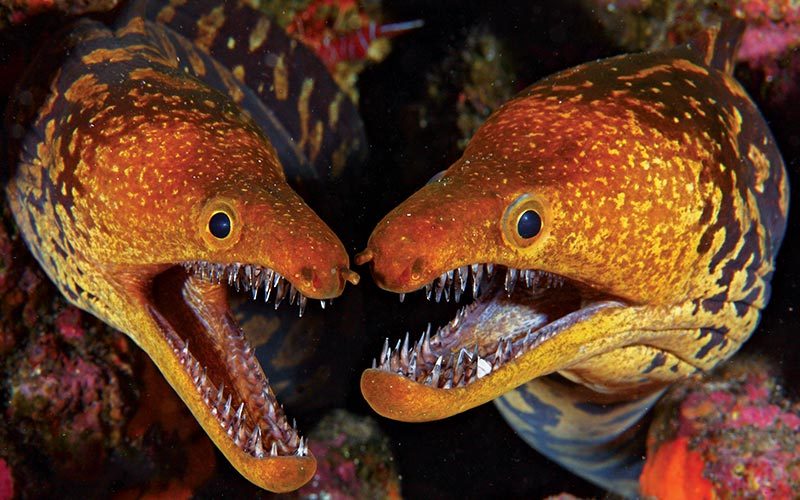
Tenerife, Canary Islands, Spain
By Luis Miguel Cortés Lozano
“I waited for a friend for a long time, and we began the dive when the sun was about to go down. At the end of the dive I saw a moray in a hole. When I was about to take the picture, another moray suddenly appeared in the same hole, and both showed me their teeth.”
Canon EOS 5D, EF 100mm f/2.8L Macro IS USM lens, 1/50 sec at f/25, ISO 400, Sea & Sea YS-250PRO strobes (2), Sea & Sea housing, www.oceanbits.com
Sixth Place
Sea Lion in Kelp Forest
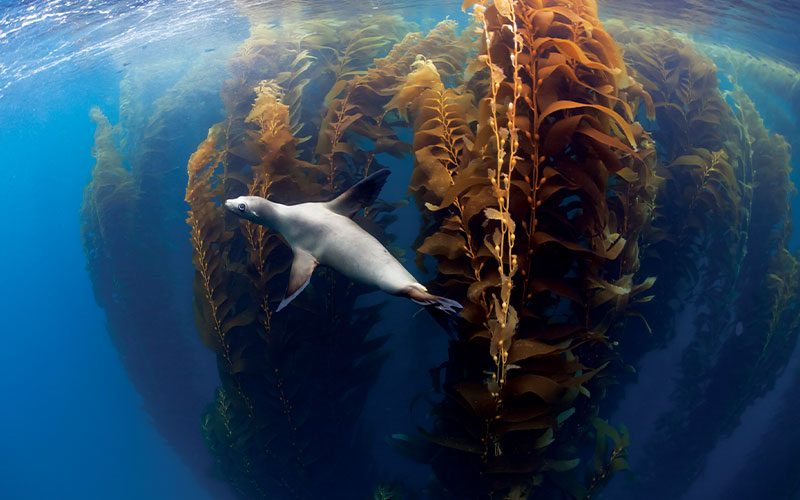
Eastern San Benito Island, Baja California, Mexico
By Claudio Contreras
“After a long dive through a kelp forest, I returned to the boat and was intercepted by a playful California sea lion. I quickly got rid of my scuba gear and went snorkeling. It was a beautiful experience to watch the kelp forest swinging to the rhythms of the current and to see this sea lion going up and down, approaching me and then losing itself in the dense mats of algae. In this picture my aim was to show the animal enjoying its environment. I was working as part of a team trying to document the diversity of the kelp forest. The trip was part of a project called Mares Mexicanos, which seeks to encourage the protection of various ecologically important marine protected areas around Mexico.”
Canon EOS 5D Mark II, Sigma 15mm f/2.8 EX DG diagonal fisheye lens, 1/320 sec at f/5.6, ISO 1600, Seacam housing, www.claudiocontreras.com
Seventh Place
Silver Garfish (Belone belone gracilis)
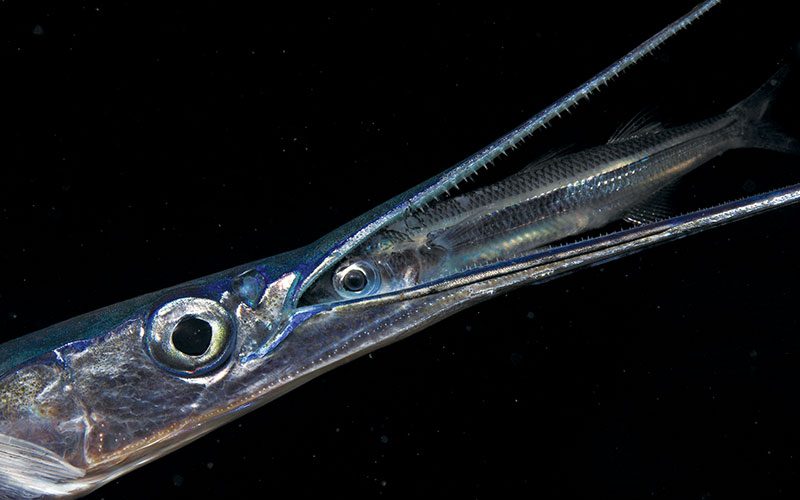
Radazul, Tenerife, Canary Islands, Spain
By Joaquin Gutierrez Fernandez
“After many days of watching these sea needles at the surface and many days out of the water not taking any photos, a magical night occurred. Patience and proximity eventually led to this image, which I’m happy to be able to share.”
Canon EOS 5D Mark II, Tamron 60mm and 1.5mm Tokina lens,1/80 sec at f/22, ISO 160, Seacam Seaflash 250 strobes and snoot, Subal housing, www.flickr.com/photos/fotografiasubmarina
Eighth Place
Green Sea Turtles
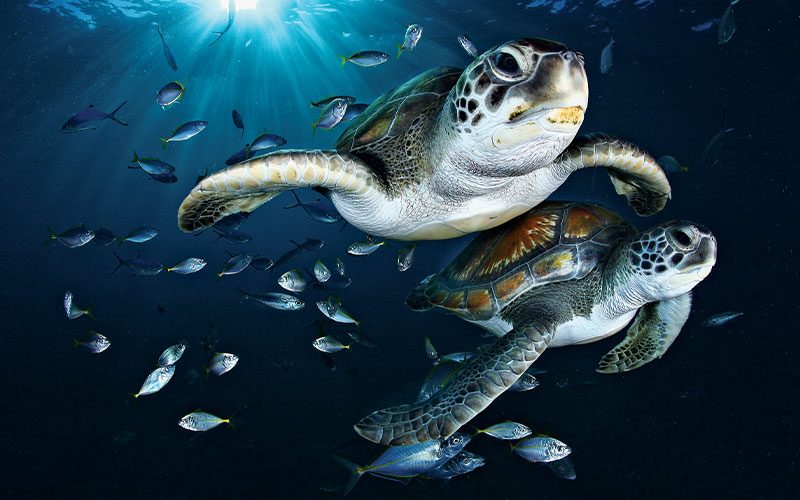
Tenerife, Canary Islands, Spain
By Francis Pérez
“I have been diving to take pictures at this place several times. The dive site features seagrass beds where you can see green sea turtles. For this photo, I wanted to take advantage of the sunrise, and that meant I had to be in the water early. I didn’t have much time; the sun rises fast, and that would spoil the atmosphere that I wanted to get. I waited a few minutes for turtles and got this picture when they appeared in the sunlight.”
Canon EOS 5D, EF 15mm f/2.8 fisheye lens, 1/160 sec at f/18, ISO 100, Ikelite DS125 strobes (2), Seacam housing, www.uwatercolors.com
Ninth Place
Iceberg
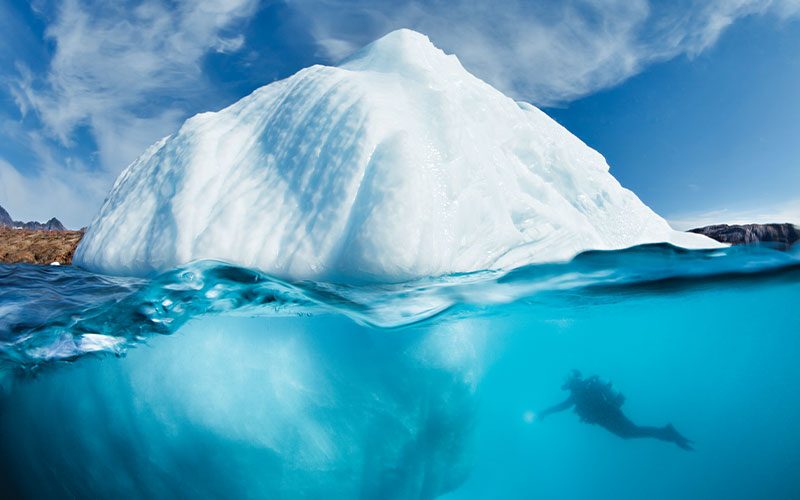
Tasiilaq, Greenland
By Tobias Friedrich
“After the sinking of the Titanic, icebergs became infamous. Ninety percent of an iceberg is below the surface, and I wanted to display the ice above and below the surface in one picture. In the small fjord of Tasiilaq, I came upon a small iceberg that was ideal for this type of picture, and I photographed a diver next to it to convey the scale.”
Canon EOS 5D Mark II, EF 8-15mm f/4.0 fisheye lens, 1/80 sec at f/20, ISO 100, UK-Germany housing, www.below-surface.com
Tenth Place
Emperor Shrimp on Nudibranch
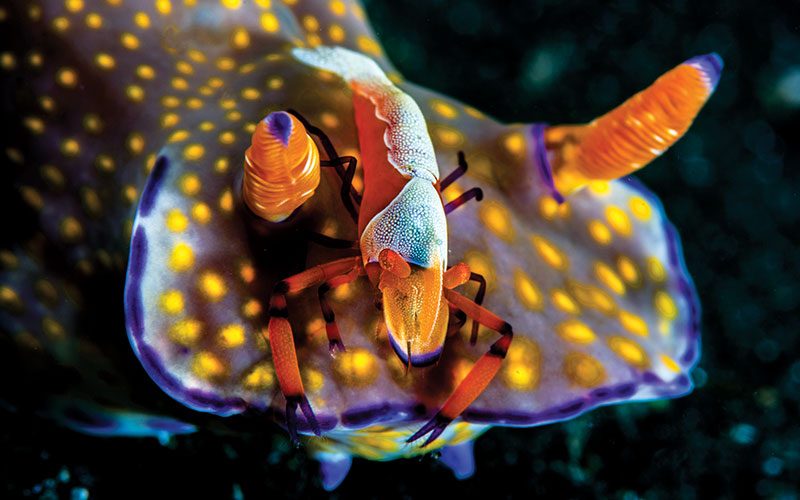
Lembeh Strait, Indonesia
By Domenico Roscigno
“I consider this one of the most spectacular symbiotic relationships in the ocean, and I have been trying to capture it for years. As often happens in underwater photography, I was presented an opportunity during a dive in which I had a lens that was not really suitable for a subject that size. I shot quickly as the shrimp came toward my lens, intrigued, just before darting away.”
Nikon D800E, AF-S VR Micro-Nikkor 105mm f/2.8G IF-ED lens, 1/320 sec at f/22, ISO 100, Inon Z-240 strobes (2), Seacam housing
Eleventh Place
Blue Whales
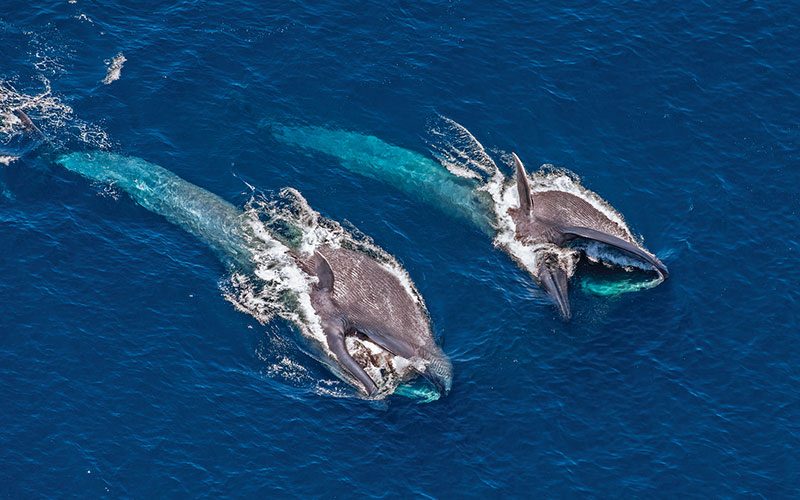
Baja California, Mexico
By Doc White
“This image is an extremely rare aerial view of a blue whale pair surfacing to feed on krill. The scene displays the enormous magnitude of the animals’ jaws and the vast quantity of water displaced during the capture.”
Nikon D700, AF-S Nikkor 300mm f/2.8G ED VR II lens, 1/1250 sec at f/7.1, ISO 640, hand-held, www.oceanmagicphotography.com
Twelfth Place
Baby Frigate Bird

Alcatrazes Islands, São Paulo, Brazil
By Cristian Dimitrius
“On a small island off the Brazilian coast lies the largest nesting place in the country for frigate birds, but there is no easy access. With the help of a researcher, I climbed up steep rocks and through dense vegetation until I found the perfect spot. I spent the whole afternoon there, and then as the sun was setting, I took several photos of a nest and captured this image of a chick calling its mother.”
Canon EOS 5D Mark II, 40mm (EF 17-40mm f/4L USM lens), 1/100 sec at f/18, ISO 100, Canon Speedlite 540EZ flash, hand-held, www.cristiandimitrius.com
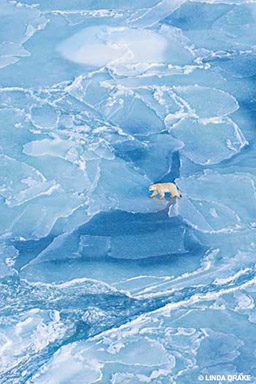
Highly Honored
Polar Bear on Hudson Bay
Churchill, Manitoba, Canada
By Linda Drake
“It was late November, and I was on a helicopter flight back to Churchill after a week of photographing bears. I’m so glad I didn’t stow my camera because I got my favorite shot of the trip from that helicopter. I tried to snap the picture when the bear crossed from one shade of ice to another, and I zoomed out to reveal the amazing patterns on the ice. Shortly after I got this shot the bear sat down by a hole in the ice, probably to hunt for seals.”
Canon EOS 1D Mark III, 70-200mm f/2.8L lens, 1/400 sec at f/7.1, ISO 400, hand-held, www.LindaDrake.com
Harlequin Shrimp and Blue Sea Star
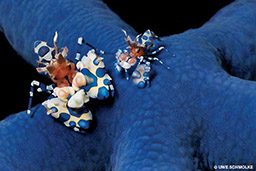
Bali, Indonesia
By Uwe Schmolke
“While diving off Bali, I spotted a female harlequin shrimp perched on a glorious blue sea star. As I was photographing it, a smaller male appeared from underneath and scuttled over. Surprisingly, the shrimp are strong enough to turn the larger star upside down and feed on it, piece by piece.”
Nikon D200, Nikkor 60mm f/2.8 macro lens, 1/125 sec at f/22, ISO 100, Nikon SB 800 strobe, Nexus housing, www.uwes-underwaterpictures.com
Surfer Cloudbreak
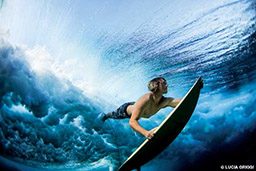
Fiji, South Pacific Ocean
By Lucia Griggi
“I took a boat ride with surfer Stu Johnson to find waves out in the Pacific. The swell was increasing, and we jumped into the tranquility and serendipity of the ocean’s rolling waves. I swam alongside Stu, as I wanted to capture what a surfer sees and feels while beneath a wave. The sun was setting, and the light was soft enough to let me grab the reflections pouring through the ocean’s surface.”
Canon 5D Mark III, EF 15mm f/2.8 fisheye lens, 1/1250 sec at f/3.5, ISO 200, SPL housing, www.luciagriggi.com
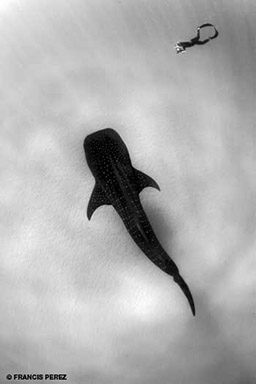
Whale Shark and Freediver
Praia do Tofo, Mozambique
By Francis Pérez
“It was the beginning of the cold season in Tofo, and after several days of diving we had not seen a single whale shark. This magnificent shark appeared on our way back to the dive center on our last day, and I captured the image while freediving.”
Canon EOS 5D, 15mm f/2.8 fisheye lens, 1/80 sec at f/9, ISO 100, Seacam housing, www.uwatercolors.com
© Alert Diver — Q2 Spring 2013